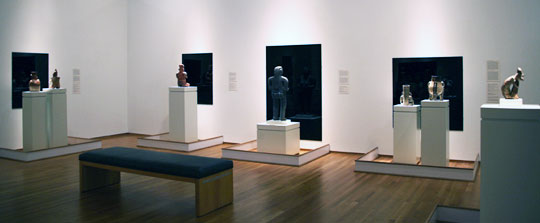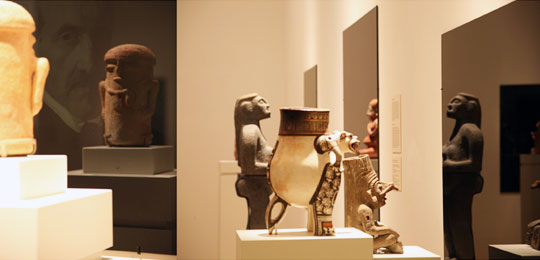Archive for the ‘BLACK MIRROR / ESPEJO NEGRO’ tag
Pedro Lasch at Nasher Museum of Art, Durham, NC

BLACK MIRROR / ESPEJO NEGRO: A Museum Installation by Pedro Lasch is one installation that I’d very much would like to see, unfortunately I doubt that I’ll be in Durham, North Carolina this year. Fortunately the press release that I received from Pedro represents the installation clearly enough to excite the imagination and leave a mental imprint.
Look carefully at the left side of the photograph below, from the black mirror a colonial Spanish face peers out to the indeginous idol and the viewer.

The pre-Columbian figures borrowed from the Nasher Museum collection have their backs turned to the museum audience as they peer into the black mirrors on the walls. Pedro Lasch describes the sculptures with their backs turned as “defiant”. Upon viewing the picture, I viewed them as defiant to the museum and museum goers who view these works out of context, stolen from their homes and delivered to static white walls and pedestals. The black mirror collapses the past and present with the embedded colonial portrait and the reflection of both the pre-Columbian figure and the viewer. However the exhibition is best described by Pedro, particularly as I haven’t seen the installation:
BLACK MIRROR/ESPEJO NEGRO: Artist Statement
Abstraction and Refusal
As we enter the room, black rectangular mirrors of different proportions dance in stark contrast to the white walls, calling attention to the structural aspects of the gallery. Facing each mirror, at different heights and depths, defiant pre-Columbian figures stand on pedestals, all of them turning their backs to the viewer. While their refusal may push us away, their reflections on the mirror pull us in. Even so, we find that it is impossible to see these figures’ faces without also encountering our own faces reflected in the same mirror. The dark flat surfaces of black glass transform images of sculptural bodies into ephemeral paintings, incorporating the viewer’s reflection, the environment and the ghostly images of yet another set of gazes, those of Spanish priests and conquistadores.
Mediation
The individual works that compose the overall sculptural installation are entitled _Black Mirror #2 through #12_, each pairing a Spanish painting of the Colonial period that emerges gradually from behind a dark sheet of glass with one or more pre-Columbian sculptures from different regions and periods. At the center we find _ Black Mirror #1_, the object that inspired the whole installation. It is an elegantly shaped obsidian disc from the museum’s permanent collection. I propose we use this black “rosetta stone” as a tool to decipher ancient Amerindian civilizations, as well as a window onto the wealth of contemporary indigenous civilizations and peoples across the American continent.Tezcatlipoca and the Obsidian Journey In pre-Columbian America, as in many other cultures, black mirrors were commonly used for divination, the art of knowing past and future events, and for necromancy, the art of communicating with the dead. The Aztecs directly associated obsidian with Tezcatlipoca, the deadly god of war, sorcery and sexual transgression. Threatened by similar associations with sorcery and deviance, Pope John XXII banned the use of mirrors for any religious purpose in 1318. Yet centuries later, obsidian plates of all shapes and sizes would be introduced into Christian altars across Spain and its colonies, eventually becoming the surface on which artists, including Spanish baroque master Bartolomé Esteban Murillo, would paint saints and virgins.
Through the Claude Glass and into the Age of Surveillance
The Spanish Colonial works appearing in this installation can be seen as early examples of two key modern and contemporary forms of representation that resemble the obsidian black mirror: the ever-present photographic camera and the _Claude Mirror _ of 18th-century Europe. Named for atmospheric painter Claude Loraine, the Claude Mirror was a portable, convex tinted glass or mirror, which painters and photographers used to create their pictures. This optical device marked a shift to a new period, when ritual and magic gave way to scientific illusionism and Colonialist expansion. We no longer use black mirrors to speak with the dead, or to fix a gaze on objects that may last a little longer than we will. Yet little black eyes still hover all around us in the form of cameras placed in many public buildings and outdoor spaces. These black mirrors still act as go-betweens between the present and the absent, the visible and the invisible, the colonizer and the colonized.
– _Pedro Lasch_